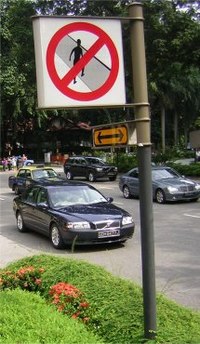Tag:crossing=no: Difference between revisions
Jump to navigation
Jump to search
(Improvements to wording, syntax and formatting) |
(Only useful if jaywalking is forbidden) |
||
| Line 15: | Line 15: | ||
Note that {{Tag|crossing|no}} excludes the existence of a crossing and therefore must be used '''without''' {{Tag|highway|crossing}}. |
Note that {{Tag|crossing|no}} excludes the existence of a crossing and therefore must be used '''without''' {{Tag|highway|crossing}}. |
||
Notice that crossing=no only really makes sense in countries like where "jaywalking" is forbidden, if pedestrians are allowed to cross everywhere this tag is useless. |
|||
== Examples == |
== Examples == |
||
Revision as of 21:28, 18 October 2023
| Description |
|---|
| Where crossing is not suitable, possible or legal. Used at places where one would expect a crossing, but there isn't one. |
| Group: crossings |
| Used on these elements |
| Status: approved |
| Tools for this tag |
|
Tagged at nodes where it is not suitable, possible or legal to cross. The tag is used at places where one would expect a crossing, but there isn't one.
Note that crossing=no excludes the existence of a crossing and therefore must be used without highway=crossing.
Notice that crossing=no only really makes sense in countries like where "jaywalking" is forbidden, if pedestrians are allowed to cross everywhere this tag is useless.
Examples

|
A place with a traffic light (highway=traffic_signals) but without a pedestrian crossing. |

|
Illegal railway crossing (text on the sign: “illegal railway crossing, 2 people died here and 2 were injured”). In such a case the railway/path intersection node can be marked with crossing=no. If there is a highway=footway it needs access=no to make clear that it should not be used (for example in routing). |
Another case may be where the geometry of a footway crosses a way of a road, but at that position, it is not possible, legal, or eligible to cross, so pedestrians (or routers) need to find the closest proper crossing to safely continue onto the footway on the other side of the road.
